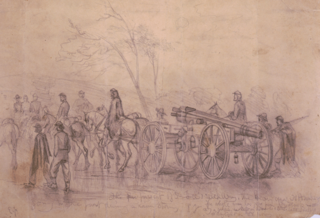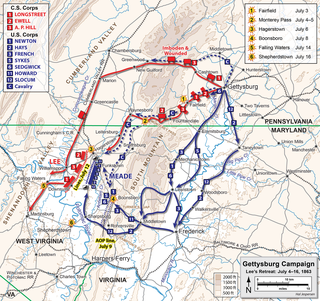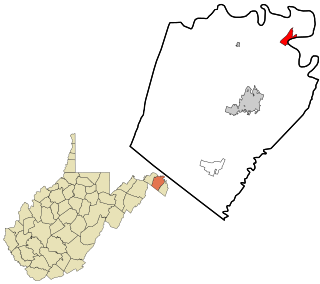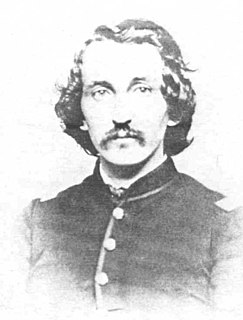Falling Waters is a census-designated place in West Virginia.
Falling Waters may also refer to:

The Battle of Hoke's Run, also known as the Battle of Falling Waters or Battle of Hainesville, took place on July 2, 1861, in Berkeley County, Virginia as part of the Manassas Campaign of the American Civil War. Notable as an early engagement of Confederate Colonel Thomas J. Jackson and his Brigade of Virginia Volunteers, nineteen days before their famous nickname would originate, this brief skirmish was hailed by both sides as a stern lesson to the other. Acting precisely upon the orders of a superior officer about how to operate in the face of superior numbers, Jackson's forces resisted General Robert Patterson's Union forces briefly and then slowly retreated over several miles.

The Battle of Williamsport, also known as the Battle of Hagerstown or Falling Waters, took place from July 6 to July 16, 1863, in Washington County, Maryland, as part of the Gettysburg Campaign of the American Civil War. It is not to be confused with the fighting at Hoke's Run which was also known as the Battle of Falling Waters.

The Battle of Boonsboro took place on July 8, 1863, in Washington County, Maryland, as part of the Retreat from Gettysburg during the Gettysburg Campaign of the American Civil War.
The Stonewall Brigade of the Confederate Army during the American Civil War, was a famous combat unit in United States military history. It was trained and first led by General Thomas J. "Stonewall" Jackson, a professor from Virginia Military Institute (VMI). His severe training program and ascetic standards of military discipline turned enthusiastic but raw recruits into an effective military organization, which distinguished itself from the First Battle of Bull Run in 1861 to Spotsylvania Court House in 1864. Its legacy lives on in the 116th Infantry Brigade, which bears the unofficial nickname "Stonewall Brigade," and in several living history reenactment groups.

Bunker Hill is an unincorporated community in Berkeley County, West Virginia, United States, located in the lower Shenandoah Valley on Winchester Pike at its junction with County Route 26 south of Martinsburg. It is the site of the confluence of Torytown Run and Mill Creek, a tributary of Opequon Creek which flows into Winchester, Virginia. According to the 2000 census, the Bunker Hill community has a population of 5,319.
The Battle of Charleston or Siege of Charleston can refer to several battles:

Falling Waters is a census-designated place (CDP) on the Potomac River in Berkeley County, West Virginia, United States. It is located along Williamsport Pike north of Martinsburg. According to the 2010 census, Falling Waters has a population of 876. An 1887 Scientific American article claimed that the first U.S. railroad was built in Falling Waters in 1814.

The U.S. state of West Virginia was formed out of western Virginia and added to the Union as a direct result of the American Civil War, in which it became the only modern state to have declared its independence from the Confederacy. In the summer of 1861, Union troops, which included a number of newly-formed Western Virginia regiments, under General George McClellan, drove off Confederate troops under General Robert E. Lee. This essentially freed Unionists in the northwestern counties of Virginia to form a functioning government of their own as a result of the Wheeling Convention. Prior to the admission of West Virginia the government in Wheeling formally claimed jurisdiction over all of Virginia, although from its creation it was firmly committed to the formation of a separate state.
The 5th West Virginia Infantry Regiment was an infantry regiment that served in the Union Army during the American Civil War.
The 5th Wisconsin Infantry Regiment was an infantry regiment that served in the Union Army during the American Civil War.

Pvt. William Jacob Covington was the first district Court Clerk of Camp County, Texas. A year following the American Civil War, Covington moved to Texas, and there in 1876, he was elected to serve as the first district court clerk of the newly-formed Camp County.

Maidstone-on-the-Potomac is a historic house and farm near Falling Waters, West Virginia. Located on the Potomac River immediately opposite Williamsport, Maryland, the property consists of a 218-acre (88 ha) tract with a main house dating from c. 1741. The house was built by Evan Watkins, who operated Watkins Ferry on the Potomac, which was used by George Washington and General Edward Braddock.

The Confederate Army of Northern Virginia began its Retreat from Gettysburg on July 4, 1863. Following General Robert E. Lee's failure to defeat the Union Army at the Battle of Gettysburg, he ordered a retreat through Maryland and over the Potomac River to relative safety in Virginia. The Union Army of the Potomac, commanded by Maj. Gen. George G. Meade, was unable to maneuver quickly enough to launch a significant attack on the Confederates, who crossed the river on the night of July 13 into South Mountain through Cashtown in a wagon train that extended for 15–20 miles, enduring harsh weather, treacherous roads, and enemy cavalry raids. The bulk of Lee's infantry departed through Fairfield and through the Monterey Pass toward Hagerstown, Maryland. Reaching the Potomac, they found that rising waters and destroyed pontoon bridges prevented their immediate crossing. Erecting substantial defensive works, they awaited the arrival of the Union army, which had been pursuing over longer roads more to the south of Lee's route. Before Meade could perform adequate reconnaissance and attack the Confederate fortifications, Lee's army escaped across fords and a hastily rebuilt bridge.
The 1st Ohio Cavalry Regiment was a cavalry regiment that served in the Union Army during the American Civil War.

1st Maryland Cavalry Battalion, Potomac Home Brigade, originally organized as the 1st Potomac Home Brigade Cavalry, "Cole's Cavalry" was formed under the guidance of Henry A. Cole. There are also references to it being designated as Cole's 1st Volunteer Maryland Cavalry. The unit, a battalion, originally consisted of four companies, A, B, C & D and was initially enlisted between August 10 and November 27, 1861.
1st Ohio Independent Light Artillery Battery was an artillery battery that served in the Union Army during the American Civil War.
The 5th Connecticut Infantry Regiment was an infantry regiment that served in the Union Army during the American Civil War.
The 29th Pennsylvania Volunteer Infantry was an infantry regiment that served in the Union Army during the American Civil War.

Charles M. Holton was an American soldier who fought with the Union Army in the American Civil War. Holton received his country's highest award for bravery during combat, the Medal of Honor, for actions taken on July 14, 1863 during the Battle of Williamsport.